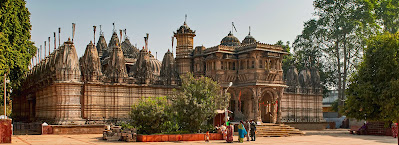 |
| HUTHEESING JAIN TEMPLE |
HUTHEESING JAIN TEMPLE
We extend our necks and squint. It is early afternoon and
the Sun is glaring downward on us, obscuring our vision. The cruel gaze of the
Sun disguises the subtleties of the transcending structure into a drape of
dark. We are close to the doors of Hutheesingh Jain Temple in Ahmedabad,
Gujarat—the most amazing Jain sanctuary in the city.
Gujarat is home to an enormous number of Jains. In
Ahmedabad, a large portion of the Jains follow the svetambara way of thinking.
Any place the Jains went, they took up the language, dressing and culture of
the space. This empowered them to keep up with their unmistakable method of
living without getting acclimatized with different religions. The Gujarati
Jains generally relocated from Northern and Eastern India. One of the holiest
of Jain locales is Shatrurjaya Hills close to Bhavnagar which is found 240
kilometers south west of Ahmedabad. It has 980 Jain sanctuary buildings each
having different sanctuaries of the 24 Tirthankaras.
 |
| HUTHEESING JAIN TEMPLE |
Entering through the door, as we go nearer to the
transcending structure, obscurity retreats and shadings arise. The 78 feet
Mahavir Stambha is the furthest down the line expansion to the rambling
sanctuary yard. In engineering, it takes after the Vijay Stambha inside Chittor
Fort in Rajasthan. A portion of the imaginativeness exhibited in the pinnacle
depicts an Islamic impact from the Sultanate time frame.
The external veneer of the sanctuary is more fabulous than
the pinnacle. Hutheesingh Jain Temple was finished in 1848 by Sethani
Harkunvar, the widow of Seth Keshar Singh Hutheesingh, in recognition of her
better half who was a rich shipper. The sanctuary is committed to the fifteenth
Jain Tirthankara, Lord Dharamnath. Photography is precluded inside the
sanctuary. Enthusiasts and guests need to eliminate their footwear prior to
entering the sanctuary premises.
The building is a melody in sandstone. The perplexing carvings on the sanctuary exterior's columns, pilasters and dividers capture us. Underlying yellow sandstone obtained from the close by spaces of Gujarat, the sanctuary is overflowing with stories on its boards. Yellow sandstone is more fragile than red sandstone making chiseling on it a troublesome issue. The platforms around a piece of the sanctuary bears witness to a training found in every one of the Jain Temples—they are each of the a consistently progressing development.
Inside the sanctuary premises the evening Sun to some degree
illuminates the patio trimmed by wavy archways. Emblematically, passing under
an archway is viewed as favorable in both Hinduism and Jainism. The shaft of
light forms an enormous atmosphere. The focal sanctorum is braced by 54 more
modest sanctuaries with 24 monotonous symbols of Tirthankaras. The corners are
decked with Persian decorate work frequently found in the Islamic foundations.
The sanctorum is etched with themes of apsaras, artists,
reptiles, warm blooded creatures, birds, tedious mathematical plans, and
semi-naked ladies singing, moving and preparing in a sola shringar way, in
recognition of God. Figures of lions and elephants support the columns. Devils
hold archways in their mouth. Stony petals of lotus spread out on the roof.
Jasper trims flicker in the cleft of the place of worship. Persian containers,
crystal fixtures and incense burners upgrade the heavenly air. 6 Tirthankaras
rest in the storm cellar of the sanctuary. The symbols are not to be gazed
straight however just through the appearance in a mirror. A light has been
consuming in the storm cellar throughout the previous 170 years. Incidentally,
the Gujarati Jains are really rich that a large portion of them have strayed
away from the matter of love. The Jain sanctuaries regularly wind up employing
Hindu pujaris to direct strict customs and functions.
In the 54 more modest sanctuaries which are nearby the
normal yard, the Tirthankaras sit on a stage with a little square in the
middle. The squares have creature designs carved over them—one of the
distinctive elements of the icons of the Tirthankaras here. The icon of Lord
Parsvanath is recognizable because of the presence of a snake hood.

